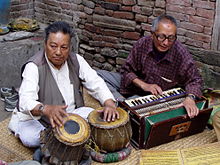
Back हरमुनिया Bihari Druckwindharmonium German Intialainen harmoni Finnish Harmonium indien French हारमोनियम Hindi
This article needs additional citations for verification. (January 2024) |


The Indian harmonium, hand harmonium, samvadini, peti ("box"), or baja, often just called a harmonium, is a small and portable hand-pumped reed organ which is very popular in the Indian subcontinent.[1] The sound resembles an accordion or other bellows driven free-reed aerophones.[1]
Reed-organs arrived in India during the mid-19th century, possibly with missionaries or traders.[2] Over time they were modified by Indian craftsmen to be played on the floor (since most traditional Indian music is done in this fashion), and to be smaller and more portable.[1]
This smaller Indian harmonium quickly became very popular in the Indian music of the 19th and 20th century. It also became widely used for Indian devotional music played in temples and in public. The Indian harmonium is still widely used today by Sikhs, Hindus, Muslims and Buddhists for devotional genres like qawwali, ghazal, kirtan and bhajan. In South Asia, the harmonium is most widely used to accompany vocalists.[1]
The Indian harmonium has also recently become popular in the Western yoga subculture. It was popularized by American kirtan singers like Krishna Das and Jai Uttal.
A related instrument is the Shruti box, a keyless harmonium, used only to produce drones to support other soloists.
© MMXXIII Rich X Search. We shall prevail. All rights reserved. Rich X Search